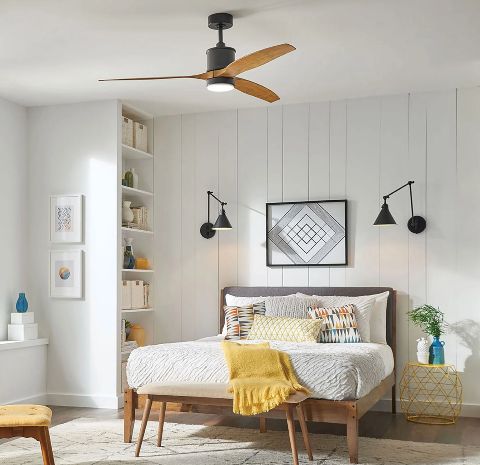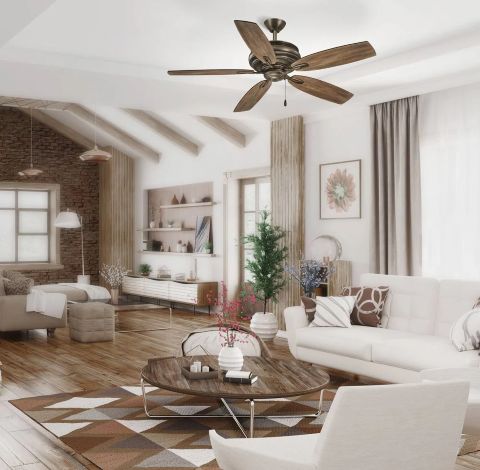While choosing a ceiling fan may seem simple enough, there’s more to the decision-making process than meets the eye! Beyond aesthetics, a crucial question arises: how many blades should it have? This seemingly simple choice impacts both function and style.
This guide cuts through the fluff to focus on the facts. We’ll explore how blade count affects airflow and efficiency, then delve into the advantages and disadvantages of different options. Finally, we'll unveil the truth: in most cases, aesthetics often trump functionality regarding blade count.
Whether you’re looking for maximum airflow or a stylish statement piece, by the end of this guide, you’ll have the confidence to choose the perfect ceiling fan for your home.
The Role of Blades in Ceiling Fan Performance
Ceiling fans are a staple in many homes, silently keeping us cool. But have you ever wondered how those seemingly simple blades create a refreshing breeze? Before we dig into how many blades you need, let’s talk about the science behind the blades themselves. At its core, a ceiling fan works by rotating blades that push air around the room. As the blades spin, they create areas of high and low pressure. The low-pressure zone above the blades pulls air upwards, while the high-pressure zone below pushes air outwards. This creates a circular motion of air that we feel as a cool breeze.
The Wind Chill Effect
While ceiling fans don’t directly lower the air temperature, they create a wind chill effect. Imagine a breezy day outside – the air feels cooler, right? This is because moving air increases the evaporation rate from your skin, making you feel more comfortable. Ceiling fans replicate this effect, creating a perceived coolness that allows you to raise your thermostat setting and save energy.
While the number of blades can influence airflow to some extent, it’s not the sole factor. Blade pitch and motor power play a much more significant role in a fan’s efficiency. Similar to an airplane wing, the angle of a ceiling fan blade, known as its pitch, affects how efficiently it moves air. A higher pitch creates a stronger force, pushing more air with each rotation. This translates to better air circulation and a stronger cooling effect. A powerful motor translates to faster blade rotation, creating more airflow. However, more robust motors also consume more energy. Finding the right balance between motor power and energy efficiency for your home is critical.
So, while blade count can influence airflow, factors like blade pitch and motor power significantly impact a ceiling fan’s performance. Modern blade designs often bridge the gap between different blade counts. Ultimately, the best choice for your home depends on your priorities. If maximizing airflow is essential, focus on blade pitch and motor power. If aesthetics are a more significant concern, a well-designed fan with your preferred blade count will likely deliver sufficient performance.
Does the Number of Blades on a Ceiling Fan Matter?
Now, let’s delve into the truth behind blade count and its impact on cool comfort. Traditionally, the belief was that more blades translated to better airflow and cooling. However, the reality is a bit more nuanced.
With more blades, you can create a smoother, quieter airflow due to less air disruption with each blade rotation. However, more blades can create drag on the motor, potentially slowing down rotation speed and reducing overall airflow volume.
Conversely, fewer blades generally allow for faster motor speeds due to less drag, potentially resulting in higher air volume. However, the airflow might be choppier due to less frequent blade interaction with air.
The number of blades does influence air movement, but it’s not the sole factor. While more blades can create a smoother airflow, fewer blades with a powerful motor can move a larger air volume. The speed of air circulation depends more on the motor power and blade pitch (the angle of the blades) than the number of blades.
A common misconception is that more blades directly equate to stronger cooling. Here’s the truth: Ceiling fans don’t lower the room temperature! They create a wind chill effect, making you feel cooler by increasing sweat evaporation. A strong airflow, regardless of blade count, is key to achieving this effect.
So, does the number of blades matter? In most cases, modern fan designs with advancements in blade shape and motor technology have minimized the performance difference between blade counts. The best choice for you depends on your priorities:
- Prioritize Airflow: Focus on motor power and blade pitch for a cool breeze.
- Prioritize Aesthetics: If a specific blade count complements your style, a well-designed fan will likely deliver sufficient airflow.
Comparing 3-blade and 5-blade Ceiling Fans
The number of blades is a prominent consideration when selecting a ceiling fan. Both 3-blade and 5-blade options offer distinct advantages, and the best choice hinges on your priorities for style, performance, and efficiency.
With clean lines and an uncluttered design, 3-blade ceiling fans are renowned for their modern, minimalist aesthetic. Here’s what makes them stand out:
- High-Speed Potential: With fewer blades, 3-blade fans often experience less drag, allowing for potentially faster motor speeds. This can translate to a powerful burst of air circulation, perfect for creating a refreshing breeze.
- Modern Minimalist Appeal: The 3 blades’ simple elegance complements modern and contemporary design schemes. Their clean lines create a sense of openness and airy spaciousness.
Often featuring intricate blade designs that can enhance the visual appeal of your space, 5-blade ceiling fans offer a more traditional aesthetic. Here are some of their key benefits:
- Noise Reduction: The additional blades help create a smoother airflow, potentially reducing the choppiness sometimes experienced with 3-blade fans. This can result in a quieter overall operation.
- Design Versatility: 5-blade fans come in various styles, from classic to ornate. You’re more likely to find a design that complements traditional or transitional spaces.
While the number of blades can influence performance, it’s not the sole factor. In most cases, there’s no significant difference in energy consumption between 3-blade and 5-blade fans, assuming similar motor power. Both can be energy-efficient options.
While 5 blades might seem like they’d distribute air more evenly, a well-designed 3-blade fan with a powerful motor can achieve sufficient air circulation throughout a room. Blade pitch (the angle of the blades) also plays a significant role in air distribution.
Remember, modern blade design and motor technology advancements have minimized the performance gap between blade counts. Regardless of the number of blades you choose, ensure the fan has a powerful motor and an appropriate blade pitch for your desired airflow.
Are More Blades Better on a Ceiling Fan?
The allure of a ceiling fan lies in its ability to keep you cool and comfortable during hot weather. But with so many options available, a crucial question arises: are more blades better? Imagine a ceiling fan as a team effort – the motor spins the blades, pushing air. Adding blades increases the workload on the motor. Here’s why:
- Drag: Each blade creates drag as it rotates through the air. More blades translate to more drag, requiring the motor to work harder to maintain speed. This could reduce overall efficiency.
- Energy Consumption: A fan with a less powerful motor struggling to overcome drag from numerous blades might consume more energy despite not necessarily producing a stronger airflow.
While fewer blades might seem ideal for peak efficiency, there are situations where a higher blade count can be beneficial:
- Larger Rooms: For expansive spaces, more blades can help ensure even air distribution throughout the room. A 5-blade fan, for example, might create a more consistent airflow than a 3-blade fan in a large living room.
- Noise Reduction: Additional blades can disrupt airflow less frequently, potentially creating a smoother and quieter operation.
Ultimately, the ideal blade count depends on your priorities. Remember, a well-designed 3-blade fan can deliver impressive airflow, while a 5-blade fan with a less powerful motor might be quieter or more efficient. More blades aren’t necessarily better. Consider your needs – prioritize airflow and efficiency, noise reduction, or aesthetics – and choose a fan with the right blade count, motor power, and blade pitch to achieve optimal performance and comfort in your home.
How Many Blades Should Your Ceiling Fan Have?
While aesthetics are important, let’s delve deeper into how room size, environment, and functionality influence the ideal blade count. The number of blades can impact air distribution, especially in rooms of varying sizes:
- Small to Medium Rooms (up to 150 sq. ft.): A 3-blade fan can excel here. Their efficient design often creates powerful airflow, perfect for smaller spaces.
- Medium to Large Rooms (150 sq. ft. - 400 sq. ft.): Three or five blades can achieve a good balance. Focus on motor power and blade pitch for optimal air circulation. For huge rooms, consider a five-blade fan to ensure even air distribution.
- Extra Large Rooms (over 400 sq. ft.): Prioritize air distribution. A 5-blade fan with a powerful motor can help circulate air effectively throughout the entire space.
Ceiling height can also influence your choice:
- Standard Ceilings (8 - 9 ft.): With proper installation, most blade counts (3 or 5) will work well.
- High Ceilings (over 9 ft.): Consider a downrod extension kit to position the fan for optimal airflow. A 5-blade fan might be slightly better suited for very high ceilings due to its potential for creating a broader airflow pattern.
The environment in which you’ll be using the fan can also be a factor:
- Indoors: Focus on noise levels and aesthetics alongside airflow. Depending on your priorities, both 3 and 5-blade options can be effective.
- Outdoors: Prioritize durability and wind resistance. A 3-blade fan might be a better choice for withstanding outdoor elements.
Ultimately, the ideal blade count hinges on your priorities. Consider your room size, ceiling height, environment, and desired noise level.
Aesthetic Considerations: Finding Your Style
Ceiling fans are no longer just functional appliances; they can be stunning design elements that elevate the aesthetics of your space. While functionality is crucial, the number of blades on your fan can significantly impact its visual appeal:
- Minimalist: Clean lines and a sleek design make 3-blade fans ideal for modern and contemporary spaces. They create a sense of openness and airy spaciousness, complementing minimalist aesthetics.
- Traditional: A timeless choice, 4-blade and 5-blade fans offer a more traditional aesthetic. The additional blades can add visual weight and balance to a room, particularly in classic or transitional décor spaces.
- Industrial: For an industrial-inspired look, consider fans with even more blades (6 or more) or unique blade shapes. These bold statements can add a touch of raw, mechanical charm to your space.
While 3 and 5-blade options are popular, don’t be afraid to explore unconventional blade counts. Fans with 2 blades can make a bold, modern statement in the right setting. These are ideal for those seeking a unique focal point in their space. Fans with asymmetrical blade arrangements or a combination of different blade lengths can add a touch of artistic flair to your home.
Remember, there are no hard and fast rules. The ideal blade count for your fan hinges on the overall aesthetic you wish to achieve.
Making the Decision: What’s Best for Your Home
The best blade count often comes down to personal preference. Think about the specific needs of your space – is maximizing airflow essential, or do you prioritize a quieter operation? Once you’ve considered these practicalities, unleash your creativity! Modern fan technology has minimized performance gaps between blade counts, allowing you to explore designs that complement your unique style.























